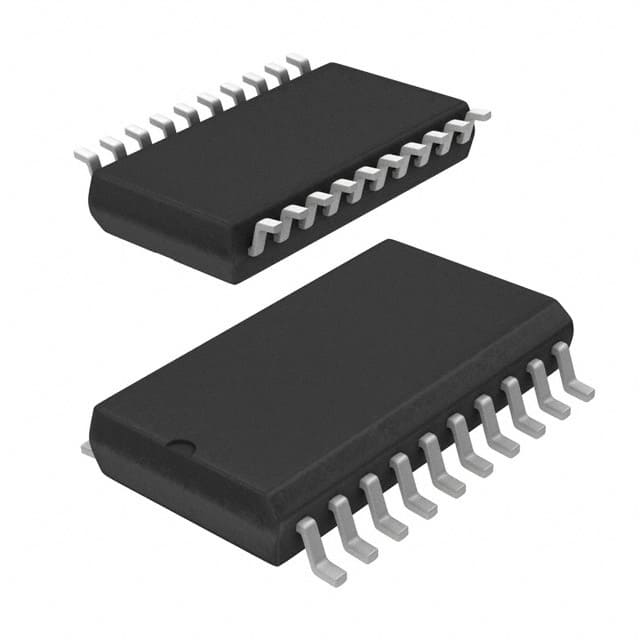Encyclopedia Entry: 74ABT373CSC
Product Overview
Category
The 74ABT373CSC belongs to the category of integrated circuits (ICs) and specifically falls under the category of flip-flops.
Use
This IC is commonly used in digital electronics for storing and transferring data. It serves as an octal transparent latch with 3-state outputs.
Characteristics
- Octal transparent latch
- 3-state outputs
- High-speed operation
- Low power consumption
- Wide operating voltage range
- Schmitt-trigger action on all inputs
Package
The 74ABT373CSC is available in a small outline integrated circuit (SOIC) package. This package provides a compact and reliable form factor for easy integration into electronic circuits.
Essence
The essence of the 74ABT373CSC lies in its ability to store and transfer data efficiently, making it a crucial component in various digital systems.
Packaging/Quantity
The 74ABT373CSC is typically packaged in reels or tubes, containing a specific quantity of ICs per package. The exact packaging and quantity may vary depending on the manufacturer and supplier.
Specifications
- Supply Voltage Range: 4.5V to 5.5V
- Input Voltage Range: 0V to VCC
- Output Voltage Range: 0V to VCC
- Operating Temperature Range: -40°C to +85°C
- Maximum Clock Frequency: 100 MHz
- Number of Flip-Flops: 8
Detailed Pin Configuration
The 74ABT373CSC has a total of 20 pins, each serving a specific function. The pin configuration is as follows:
- D0: Data input 0
- D1: Data input 1
- D2: Data input 2
- D3: Data input 3
- D4: Data input 4
- D5: Data input 5
- D6: Data input 6
- D7: Data input 7
- GND: Ground
- Q0: Output 0
- Q1: Output 1
- Q2: Output 2
- Q3: Output 3
- Q4: Output 4
- Q5: Output 5
- Q6: Output 6
- Q7: Output 7
- OE: Output enable
- CP: Clock pulse
- VCC: Supply voltage
Functional Features
The 74ABT373CSC offers the following functional features:
- Octal transparent latch with 3-state outputs
- High-speed operation allows for efficient data transfer
- Schmitt-trigger action on all inputs ensures reliable signal processing
- Output enable (OE) pin enables or disables the outputs, providing flexibility in controlling data flow
Advantages and Disadvantages
Advantages
- High-speed operation facilitates quick data transfer
- Low power consumption helps conserve energy
- Wide operating voltage range allows for compatibility with various systems
- Schmitt-trigger action enhances noise immunity and signal integrity
Disadvantages
- Limited number of flip-flops (8) may restrict its application in larger systems requiring more storage capacity
- Requires careful handling and proper circuit design to avoid damage or malfunction
Working Principles
The 74ABT373CSC operates based on the principles of latch-based memory storage. When the clock pulse (CP) is triggered, the data inputs (D0-D7) are latched and stored in their respective flip-flops. The stored data can then be accessed through the output pins (Q0-Q7). The output enable (OE) pin controls the state of the outputs, allowing them to be either enabled or disabled.
Detailed Application Field Plans
The 74ABT373CSC finds applications in various digital systems where data storage and transfer are essential. Some specific application field plans include:
- Microprocessors: Used as a temporary storage element for data during processing.
- Data communication systems: Facilitates buffering and synchronization of data between different components.
- Memory modules: Enables efficient read and write operations in memory devices.
- Control systems: Provides latch-based storage for control signals and status information.
Detailed and Complete Alternative Models
There are several alternative models available that serve similar functions to the 74ABT373CSC. Some notable alternatives include:
- 74HC373: A CMOS-based octal latch with 3-state outputs.
- SN74LS373: A TTL-based octal transparent latch with 3-state outputs.
- CD4013: A dual D-type flip-flop IC with complementary outputs.
These alternative models offer similar functionalities but may differ in terms of voltage compatibility, speed, and
तकनीकी समाधानों में 74ABT373CSC के अनुप्रयोग से संबंधित 10 सामान्य प्रश्नों और उत्तरों की सूची बनाएं
Sure! Here are 10 common questions and answers related to the application of 74ABT373CSC in technical solutions:
Q: What is the 74ABT373CSC? A: The 74ABT373CSC is a transparent latch with 3-state outputs, commonly used in digital circuits.
Q: What is the purpose of the 74ABT373CSC? A: The purpose of this IC is to store and hold data temporarily in a digital circuit.
Q: How many bits can the 74ABT373CSC latch hold? A: The 74ABT373CSC can hold 8 bits of data.
Q: Can the 74ABT373CSC be used as an input or output device? A: Yes, it can be used for both input and output purposes in a digital system.
Q: What is the significance of the 3-state outputs in the 74ABT373CSC? A: The 3-state outputs allow multiple devices to share a common bus without interfering with each other.
Q: How does the 74ABT373CSC latch data? A: The latch stores data when the latch enable (LE) input is high and transfers the stored data to the outputs when the output enable (OE) input is low.
Q: Can the 74ABT373CSC be cascaded to increase the number of bits stored? A: Yes, multiple 74ABT373CSC latches can be cascaded to increase the number of bits stored.
Q: What is the power supply voltage range for the 74ABT373CSC? A: The typical power supply voltage range for this IC is 4.5V to 5.5V.
Q: Can the 74ABT373CSC handle high-speed data transfers? A: Yes, it is designed to operate at high speeds and can handle fast data transfers.
Q: What are some common applications of the 74ABT373CSC? A: The 74ABT373CSC is commonly used in microprocessors, memory systems, and other digital systems where temporary storage of data is required.
Please note that these questions and answers are general and may vary depending on specific technical requirements and implementations.


